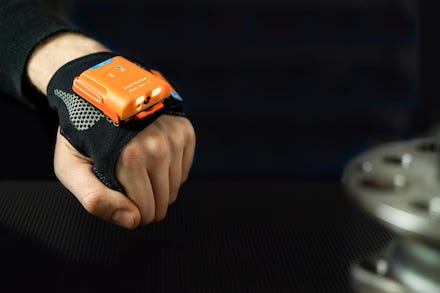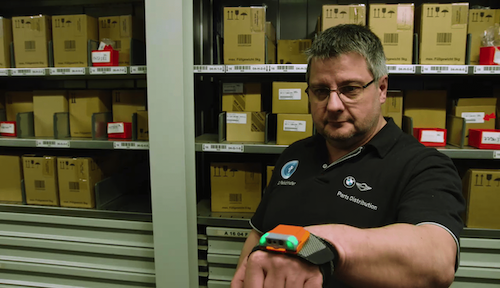Five Challenges of Using a Traditional Pistol Scanner in Industrial Environments
 When it comes to selecting a barcode scanner, the market offers devices that not only differ in price, but also ergonomics, weight, reliability, battery life and many other factors. One of the most commonly used models is the pistol scanner; a traditional barcode scanning device that is operated by pulling a trigger. But while the pistol scanner has been popular throughout many industries, through innovation there are now a number of new barcode scanning applications that have come to market that address a number of challenges presented by conventional pistol scanners. ProGlove, a leading supplier of industrial wearables, points out the main issues arising from this type of scanner:
When it comes to selecting a barcode scanner, the market offers devices that not only differ in price, but also ergonomics, weight, reliability, battery life and many other factors. One of the most commonly used models is the pistol scanner; a traditional barcode scanning device that is operated by pulling a trigger. But while the pistol scanner has been popular throughout many industries, through innovation there are now a number of new barcode scanning applications that have come to market that address a number of challenges presented by conventional pistol scanners. ProGlove, a leading supplier of industrial wearables, points out the main issues arising from this type of scanner:
- Health and safety: Considering the number of items that workers scan each day, the physical repetition that comes from picking up, using and holstering a pistol scanner for each individual item can contribute to repetitive strain injury (RSI). According to the Bureau of Labor Statistics, one out of every three worker injury or illness cases involves musculoskeletal disorders. Because of that, there is an added element of importance to deploy hands-free wearable technology to benefit the safety of workers.
- Breakable and unreliable devices: Given the format of the traditional pistol scanner, the devices are more prone to break as they are easily dropped on the floor or knocked while stored on the worker’s belt. As the devices are not ruggedized, replacements are regularly required. This can be frustrating for workers and the organization, as workers cannot operate with optimum efficiency.

- Low efficiency levels: Efficiency is paramount within the supply chain, and you can save valuable time during the scanning process if workers are given the best tools for the job. With the pistol scanner, significant time is lost for each worker because of the repetitive nature of picking up, using and holstering the scanner for each product. Instead, wearable technology like ProGlove’s lightweight wearable barcode scanners can drastically boost efficiency by helping to save users up to 4 seconds per scan, while reducing typical picking errors by up to 33 percent.
- Lost devices: Another drawback of the pistol scanner is that workers can misplace or lose them. This could be around the warehouse or factory, but it’s also possible that a worker may leave the scanner inside one of the boxes that they are packing. This is a surprise for the customer, to say the least, but also results in economic losses for the company because of the need to replace the scanner.
- Lack of employee motivation: The traditional pistol scanner hasn’t changed much over the years to adapt to the evolving needs of the worker, which makes it an uninspiring tool to work with. Instead, with the improvements wearable technology offer in daily routines, including removing needless repetition, improving precision and reducing physical strain, workers’ jobs are safer and more straightforward. Wearable technology can improve workers' conditions and increase their productivity and motivation levels.
Thomas Kirchner, Vice President Product at ProGlove comments: “Barcode scanning is a fundamental process across numerous industries. Legislation, technical evolution and customer demand create an urgent necessity for accurate and efficient barcode scanning. Organizations must therefore consider the need to implement solutions that streamline these processes whilst keeping quality at optimum levels.
“At ProGlove, we understand the needs of the industry, so we work to offer barcode scanning solutions focused on delivering valuable efficiencies, ergonomics and ease of use scanners to improve the quality of workers’ tasks.”
In order to address this requirement, ProGlove has a wide range of products designed to meet industry demands. Its MARK product family delivers a reduction of up to four seconds in the time spent on each scanned item. ProGlove’s latest device, Reel, is an innovative wearable scanner designed to be quickly accessible via a cord or belt clip, making it ideal for organizations with low-frequency scanning environments. It allows workers to quickly and easily scan items at their fingertips, without having to carry a heavy, bulky, conventional pistol scanner – reducing the risk of breakage or losing the device.
About ProGlove
ProGlove develops industrial wearables. The smart solutions of the German headquartered company are used by more than 500 renowned organizations in manufacturing, production, logistics and retail. ProGlove was founded in December 2014 after winning the Intel "Make it Wearable" Challenge in Silicon Valley. ProGlove is backed by growth focused investors Summit Partners, DICP and Bayern Capital. ProGlove employs 200 people from over 40 countries at its two sites in Munich and Chicago. More information is available at www.proglove.com.
Other exclusive content and articles of interest:
